The Ngorongoro Crater is a caldera – a volcano cone that has collapsed inward, creating a 15-mile wide hole in the earth surrounded by a high rim on all sides. Over the eons, sediments accumulated on the crater floor and a shallow lake formed in the center of the caldera, providing an environment where abundant food and water are available year round. Here, protected from the vicious cycle of drought and heavy rains that mark the Serengeti, the animals in Ngorongoro have no need to migrate.
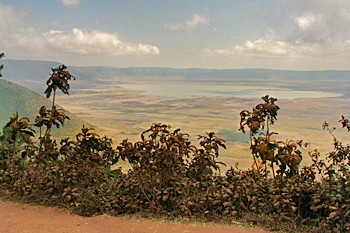
If the Serengeti is all about the big cats, Ngorongoro Crater was about zebra and wildebeest. But there are other animals to see on safari here, a few of which are shown in the following photos:
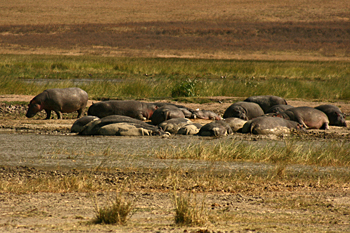
But the zebra and wildebeest are here in such massive numbers that they took my breath away. These two animals travel together because the wildebeest need the more nutritious grasses, while the zebra can exist on lower quality grasses, so they complement each other.
My first view of the immense herds of zebra and wildebeest was from the crater rim as we descended to the valley floor. Numbering in the thousands, the beasts grazed or drank at the lake’s edge. On the crater floor, we drove into the herds and patiently waited for them to move off the road. The wildebeest lounged about, lying on the ground or placidly feeding.
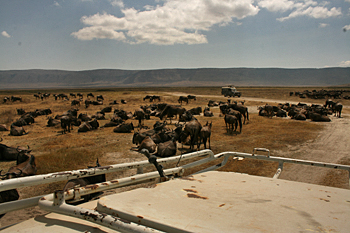
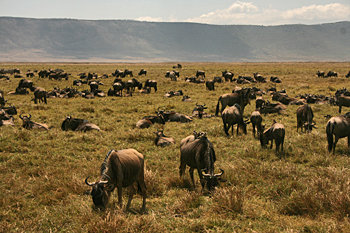
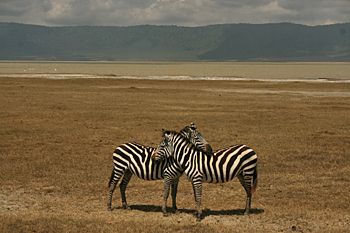
We watched as a lone wildebeest crossed the road and headed for the lake.
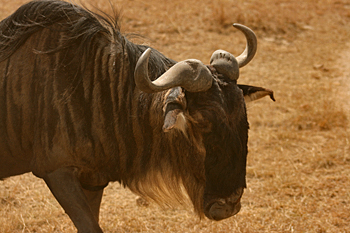
As if having received a collective silent signal, the entire herd of wildebeest slowly followed, forming a line miles long along the shore of the lake.
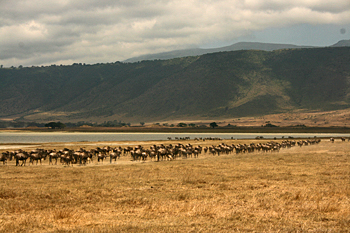
There are also rhinoceros in the crater, although they were hiding the day I toured. My guide explained that they hadn’t been seen for days because the wind was too strong. I was amused by the idea that this giant beast, which is covered in thick hide, is so afraid of the wind that they have to hunker down whenever a stiff breeze kicks up.

My itinerary had originally called for us to camp at Ngorongoro’s Simba campsite, located high on the rim of the crater. I had spoken to several people who had recently camped at Simba and all of them complained that it had been bitter cold – in fact most of them were sick from the experience. I’ve been fairly comfortable camping in temperatures that hovered in the low 50’s for the past few nights, but I figured camping at the rim would be pushing my luck. I expressed as much to my guides, who instead arranged for us to stay in a campground at a lower elevation. So up we went, once again on a rough track that switch-backed up the crater rim, to the town of Karatu where not only the temperatures were more bearable, but we were also able to take a shower for the first time I three days. I must say I needed it – I was beginning to smell!
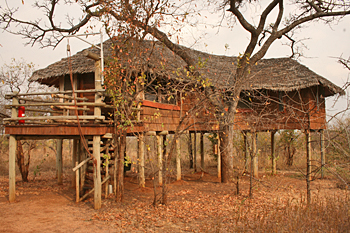
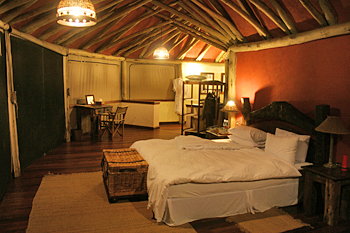
The final day of my safari was in Tarangire National Park, which was a bit anti-climactic after the experiences of Serengeti and Ngorongoro. As the sun began its descent we exited the park, headed for the Tarangire Treetops Lodge. To reach the lodge required an excruciating 13-mile drive over a road that was nothing more than two tracks over a gully-ridden rock and sand landscape. I was exhausted by the time we arrived but astonished by the facility, which is an incredibly luxurious all-inclusive resort in the absolute middle of nowhere. Individual cabins built on tall pilings are perched at the level of the treetops with views of Lake Manyara and the East African Rift escarpment beyond. Inside, the rooms feature floors and beams of exotic woods and are outfitted with every imaginable convenience. Outside is still so wild that after dark, all guests are required at have a spear-bearing Maasai accompany them whenever they leave the room, as a protection against the wild animals that freely roam here. I was so grateful to have a real shower and a Western toilet that I almost shed tears. After a gourmet dinner I crawled into my king size bed, pulled the thick duvet up around my chin, and drifted off to sleep to the sounds of the animals outside my cabin.
This morning we left via a different road – this one in a bit better condition that the one we’d used last night, but still a bone-jarring 18 miles long through red sand hills dotted with acacia trees. My guides have delivered me to the E’Manyatta Lodge in the town of Monduli and have left for their next safari. Tomorrow I begin a two day home stay with a Maasai family – I have met my host, Maroni, and he assures me I won’t be forced to eat meat or drink blood, so I am feeling a bit better about this experience. I am excited by the prospect of studying with village healers and learning about the medicinal properties of the local plants. So, once again, I will be without Internet for a few days – but I’ll be back! Who knows, by then I my have ‘gone native.’


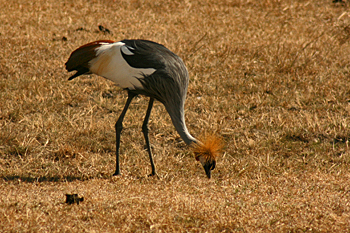
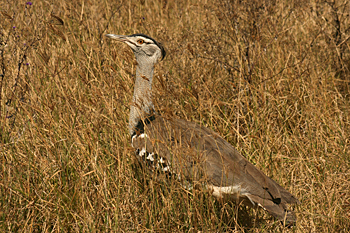
Glad I had a chance to go vicariously with you on your trip. Great!!!! Your pictures are wonderfull ; what kind of camera are you using? Sorry you did not get to Darwin. My father was injured there in WWII. Did you know that Northern Australia was bombed by the Japanese during the war. Very glad you are having a good time. We miss you on the Outer Banks.